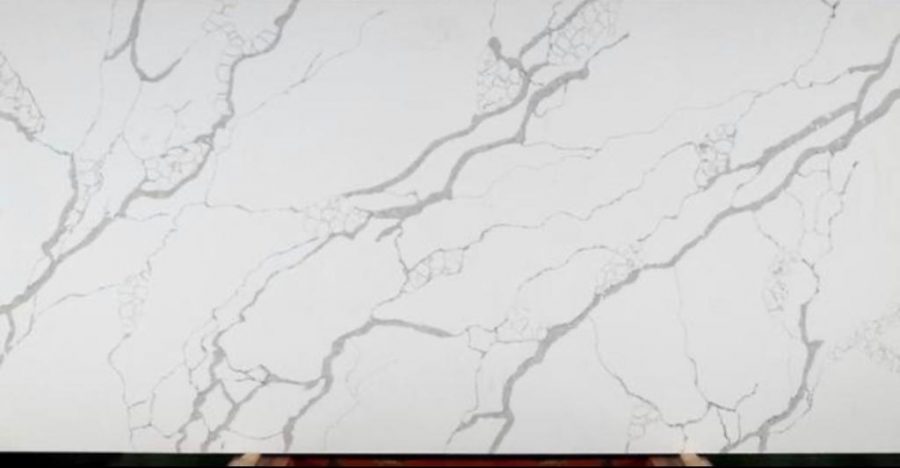
Do quartzite and quartz require different maintenance?
Although quartz and quartzite share a similar visual appearance, they have very different durability and performance qualities. Quartz stands up well to scratches, heat and stains, but is softer than quartzite.
The resin used to bind quartz makes it non-porous and resistant to staining and etching, which may reduce the overall maintenance required. However, it’s still important to use trivets and hot pads to prevent damage.
What is quartzite?
Quartzite is a natural stone that forms when quartz-rich sandstone undergoes extreme pressure and heat. Its popularity among eco-conscious homeowners is fueled by the fact that it’s 100% natural. While manufactured stone like quartz (like that made by MSI, Caesarstone, or Silestone) is composed of 90 to 99 percent ground quartz and resins, quartzite slabs contain only naturally occurring components.
Quartzite’s beauty is characterized by its unique, eye-catching composition. In addition to varying hues of light gray and white, the mineral can feature streaks or flecks of bold blues and greens. It’s also sometimes dotted with mica minerals, which creates a sparkling effect known as aventurescence. This is often seen in tumbled stones and beads, as well as in the sandstone rocks used to make arrowheads.
Due to its high-quality construction, quartzite is a durable choice for countertops that will stand up to heat, heavy use, and daily cleaning. Its low porosity, paired with regular sealing, makes it resistant to staining and pitting, making it ideal for kitchens that experience a lot of activity. Quartzite is also much more heat-resistant than granite, meaning it can safely be used around fireplaces and outdoor firepits. Quartzite’s durability also means that it can withstand light knife use, but heavier chopping should be done on a cutting board. As a result of these benefits, quartzite countertops require less maintenance than granite or marble.
How do I care for quartzite?
Quartzite is a durable material that resists heat, staining, UV fading and chipping, especially when it’s sealed. However, despite its innate strength and durability, like all natural stone it’s vulnerable to damage from common threats, including water, oils and harsh chemicals. Fortunately, the low porosity and protective layer of your sealer helps to prevent this type of damage and keeps your countertops looking pristine.
While quartz counters are more resistant to damage and stains than natural stone, they do need regular maintenance. A simple wipe-down with a damp cloth is enough to keep them clean, but you can also use a pH-neutral cleaner for added protection. Just be sure to avoid abrasive cleaners, which could scratch or dull your countertop’s surface.
If you’re concerned about stains, it’s best to clean spills and messes as soon as they happen. Quartzite can be susceptible to staining from coffee, tea, red wine and other acidic foods. It’s also important to have your quartzite resealed regularly, ideally once or twice a year depending on how much you use it.
If your quartzite counters do get stained, you can remove most marks with a commercially prepared poultice or even a paste made from baking soda and water. If you notice any chips in your countertop, call in a professional to repair them before they spread.
How do I clean quartzite?
Although quartzite is nonporous and does not need to be sealed like granite or marble, it still needs to be regularly cleaned to ensure that the stone stays in good condition. We recommend using non-abrasive cleaners made especially for natural stones and wiping down the surface with a soft, lint-free cloth on a daily basis. We also suggest using mild detergents rather than bleach, ammonia or acid-based products that could potentially damage the surface of your counters.
It is also advisable to wipe up any spills right away from food, beverages and cleaning solutions as this will help prevent staining. If you see a stubborn stains, try spraying a pH-neutral stone cleaner on the affected area and leaving it for a few minutes to give the cleaning solution time to break down the stains before wiping them away. You may need to repeat this process if the stains do not completely disappear.
You can also use a poultice to remove stains from your countertops. This is a homemade cleaning paste made from baking soda and water that you can apply to the surface of the stain. Once the poultice dries, it pulls the stain from the pores of the counter and can be scraped off with a plastic putty knife. This method can take a little bit longer than using commercial stain remover, but it will usually work just fine.
How do I seal quartzite?
The low porosity of quartzite, when paired with proper sealing, makes it highly resistant to damage like heat, etching, staining, and scratching. This makes it a practical choice for busy households flooded with family and friends, as well as gourmet kitchens filled with food prep and cooking.
Regular cleaning with a pH-neutral stone cleaner formulated for natural stone will remove residue and stains from the surface of your quartzite countertops, keeping them looking their best. Avoid cleaners with acetic or citrus acids, as these can eat away at the sealant and leave your countertop vulnerable to stains again in the future.
Once your countertop is clean and free of stains, you can use a high-quality penetrating sealant formulated for quartzite to keep it protected. Be sure to follow the manufacturer’s instructions on applying the sealant, and allow it to dry completely before using your quartzite countertops again. It’s recommended to reapply your sealant once per year or as needed, depending on your household usage patterns and maintenance schedule.
In addition to protecting the surface of your quartzite countertops with a sealant, preventative measures like using coasters for beverages and not placing hot dishes directly on the counter will help maintain its beauty and longevity. You should also avoid abrasive scrub brushes and non-abrasive sponges, which can scratch the surface of your quartzite surfaces and compromise the durability of the sealant.
Read more about quartzite vs quartz



